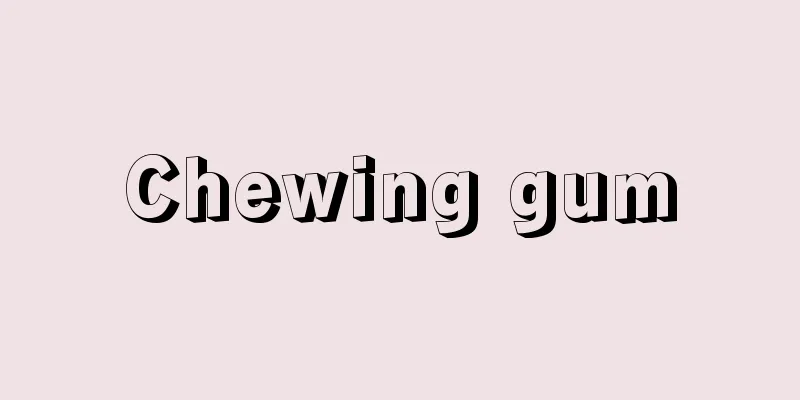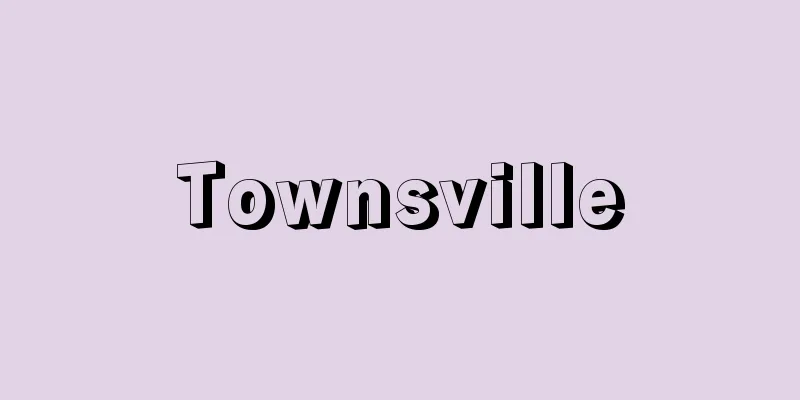Chewing gum

|
A luxury item that is chewed to enjoy its flavor and texture. Chewing gum is a compound word made up of the words "chew" and "gum." The custom of "chewing" did not exist in Japan, but there are records of the use of frankincense gum (a resin extracted from the bark of the frankincense tree) in ancient Greece. Also, in Southeast Asia, India, and other regions, processed betel nuts have been used as a luxury item to chew. [Tomomi Kono] historyThe origins of modern chewing gum date back to the indigenous Mayans of Central America (southern Mexico, Guatemala, Honduras, etc.). They had the habit of chewing solidified sap (chicle) extracted from the bark of the 15-20 meter tall sapodilla tree. This habit, passed down by the indigenous people, then spread to Spanish immigrants after the colonization of the Americas, which began at the end of the 15th century. It was American Thomas Adams (1818-1905) who commercialized it as chewing gum, and around 1860 he released a solidified sapodilla sap that he called chicle. One theory is that it was Spanish general Santa Anna who encouraged Adams to commercialize chicle. Later, chicle with added sweeteners and flavorings was developed by Adams, John Colgan (1840-1916), William Wrigley, Jr. (1861-1932), Frank Henry Fleer, and others, and spread to the United States and other parts of the world. In Japan, it was imported by Wrigley during the Taisho era, and domestically produced products also appeared in the Showa era. After World War II, chewing gum spread rapidly thanks to American soldiers stationed in Japan, and Japan's production volume was 14,000 tons in 1960 and 53,000 tons in 1971. However, it has remained stable since 1975, and in 1985 production was 33,500 tons. From the 1990s to the 2000s, it remained at around 40,000 tons. [Tomomi Kono] kindsBroadly categorized by the US FDA (Food and Drug Administration), there are recreational gums (stick gum, bubble gum, sugar-coated gum, candy gum), special nutritional gums (sugar-free gum, fortified gum), and medicated gums (cavity prevention gum, breath freshening gum, etc.). Stick gum is the most widely consumed, and by flavor there are peppermint, spearmint, fancy mint, fruit, nut, and liquor, with mint being the most popular. The main component of the gum base (base material) of chewing gum is resin, which includes natural resins such as chicle, jelutong, and sorva, and synthetic resins such as vinyl acetate resin and ester gum. [Tomomi Kono] ManufacturingSeveral types of resins, rubbers, and inorganic substances are mixed to adjust the chewiness to an appropriate level, and then seasonings, fragrances, and colorings are added, kneaded, and molded. It is important to mix the gum base evenly. [Tomomi Kono] utilityChewing is an instinctive human desire. Chewing something when you are mentally irritated can help calm you down. Chewing gum was distributed to American soldiers in their rations during World War II in order to relieve tension on the battlefield. Chewing also helps to strengthen the jaws and gums, and chewing gum after a meal can remove food particles that have stuck to the teeth. However, the sweeteners and various additives contained in chewing gum have become problematic due to their connection to tooth decay and other health issues, and there has been much discussion about the ingredients and how to use it. [Tomomi Kono] [Reference] | | |Source: Shogakukan Encyclopedia Nipponica About Encyclopedia Nipponica Information | Legend |
|
噛(か)むことで風味、食感を楽しむ嗜好(しこう)品。チューインガムは噛むchewとゴムgumの合成語である。日本には「噛む」という風俗が存在しなかったが、古代ギリシアでは乳香(にゅうこう)ガム(乳香という木の樹皮からとった樹脂)が利用された記録がある。また、東南アジア、インドなどの地域では、ビンロウの実の加工品が噛む嗜好品として利用されてきた。 [河野友美] 歴史現在のチューインガムの起源は中央アメリカ(メキシコ南部、グアテマラ、ホンジュラスなど)の先住民マヤにさかのぼる。彼らは高さ15~20メートルのサポジラの樹皮からとった樹液(チクル)を固め、これを噛む習慣があった。その後、先住民に伝わるこの習慣は、15世紀末に始まるアメリカ大陸の植民地開拓以降スペイン系移民に広がった。チューインガムとして製品化したのはアメリカ人のトーマス・アダムズThomas Adams(1818―1905)で、1860年ごろサポジラの樹液を固めたものをチクルと称して発売した。一説によればアダムズにチクルの商品化を勧めたのはスペインの将軍サンタ・アナだともいわれている。その後チクルに甘味や香料を加えたものがアダムズ、コールガンJohn Colgan(1840―1916)、リグレーWilliam Wrigley, Jr. (1861―1932)、フリーアFrank Henry Fleerなどによって開発され、アメリカをはじめ世界に広がった。日本では大正時代にリグレー社から輸入され、昭和に入って国産品も現れた。第二次世界大戦後、駐留アメリカ兵によってチューインガムは急速に広まり、1960年の日本の生産量は1万4000トン、71年は5万3000トンとなった。しかし、75年以降は横ばい状態となり、85年の生産量は3万3500トンであった。90年代~2000年代は4万トン台を維持している。 [河野友美] 種類アメリカのFDA(食品医薬局)の分類によって大別すると、嗜好ガム(板ガム、風船ガム、糖衣ガム、キャンディーガム)、特殊栄養ガム(無糖ガム、栄養強化ガム)、薬用ガム(むし歯予防ガム、口臭除去ガムその他)がある。いちばん消費量の多いのは板ガムで、フレーバーで分けるとペパーミント系、スペアミント系、ファンシーミント系、フルーツ系、ナッツ系、洋酒系などがあり、ミント系が主流である。チューインガムのガムベース(基材)の主成分は樹脂で、チクル、ジェルトン、ソルバなどの天然樹脂と、酢酸ビニル樹脂、エステルガムなどの合成樹脂がある。 [河野友美] 製造数種の樹脂やゴム質、無機質などを配合して適度な噛み心地を調節し、調味料、香料、色素を加えて練り上げ、成形する。ガムベースの配合と均一に混合することが重要なポイントである。 [河野友美] 効用噛むことは人間の本能的な欲求である。精神的にいらいらしているときに物を噛むと気分が治まる。第二次世界大戦でアメリカ兵の携帯食糧にチューインガムが配給されたのも戦場での緊張を和らげるためであった。噛むことはあごや歯ぐきを鍛えるのにも役だち、また、食後にチューインガムを噛むと歯に付着した食べかすを除去できる。一方、チューインガムに含まれる甘味料や各種添加物はむし歯やその他健康とのかかわりで問題となっており、材料や用い方について多くの異論が出ている。 [河野友美] [参照項目] | | |出典 小学館 日本大百科全書(ニッポニカ)日本大百科全書(ニッポニカ)について 情報 | 凡例 |
Recommend
Riedlinger, A.
...Professor at the University of Geneva (1891-19...
Ningbo - Ningbo
A city in the eastern part of Zhejiang Province, C...
Dorcus titanus
…Some males can reach a body length of over 7cm. ...
Oban Toneri - Oban Toneri
These were people who came to the capital from th...
university
...They were doctors with doctoral degrees, and i...
Ross, J.
…Government-sponsored geographical exploration be...
Hemichromis bimaculatus (English spelling)
…Males in heat are beautiful, with their whole bo...
Armored Corps
〘 noun 〙 A combat unit of the army composed of tan...
Cargo-passenger ship
A ship that transports both cargo and passengers. ...
Hughes, DE
…Wheatstone also invented the punching method, wh...
L'Orchestre de la Suisse Romande (English: Swiss Romande Orchestra)
The orchestra was founded in Geneva in 1918 by Ans...
Kugaiden
It can also be read as "Kugeden." Kuge ...
Minamoto no Yoshihira
A military commander in the late Heian period. He...
Daseinsanalyse (English: Daseinsanalyse) German
A method of psychopathology. It has been develope...
dharma-kāya (English spelling) dharmakaya
...In Mahayana Buddhism, the thought of the Buddh...








![Furen [town] - Furen](/upload/images/67ccac1d9109e.webp)
